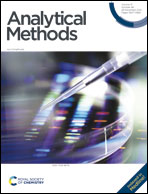Iodide-enhanced Cu-MOF nanomaterials for the amplified colorimetric detection of Fe3+†
Abstract
In this paper, a novel colorimetric strategy based on iodide ion (I−) and Cu-MOF catalysis was developed for simple, low-cost, and naked-eye detection of Fe3+. Both I− and MOFs display catalytic activity toward peroxidase substrate 3,3′,5,5′-tetramethylbenzidine (TMB). Adsorption and embedding of I− in Cu-MOF generates Cu-MOF/I with a three-dimensional porous structure that exhibits higher specific surface area, providing more active sites to facilitate interaction with TMB, resulting in enhanced catalytic efficiency. Reports have shown that Fe3+ can oxidize TMB in the absence of H2O2. We found that as Fe3+ concentration increases, the color of the system gradually deepens and the UV absorption peak gradually increases, thus providing a colorimetric sensor for quantitative Fe3+ detection. The detection limit (LOD) obtained in the presence of I− is 200 nM; however, in the absence of I−, the LOD is approx. 10 μM. Thus, the sensing system is ideal for signal amplified analysis of Fe3+. In the presence of various interfering metal ions, the developed sensing system displays excellent selectivity. Additionally, the practical application to Fe3+ detection in real samples is explored.



 Please wait while we load your content...
Please wait while we load your content...